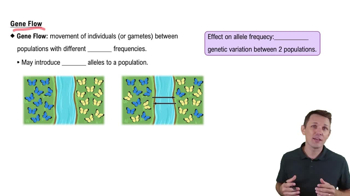Table of contents
- 1. Introduction to Biology2h 42m
- 2. Chemistry3h 40m
- 3. Water1h 26m
- 4. Biomolecules2h 23m
- 5. Cell Components2h 26m
- 6. The Membrane2h 31m
- 7. Energy and Metabolism2h 0m
- 8. Respiration2h 40m
- 9. Photosynthesis2h 49m
- 10. Cell Signaling59m
- 11. Cell Division2h 47m
- 12. Meiosis2h 0m
- 13. Mendelian Genetics4h 44m
- Introduction to Mendel's Experiments7m
- Genotype vs. Phenotype17m
- Punnett Squares13m
- Mendel's Experiments26m
- Mendel's Laws18m
- Monohybrid Crosses19m
- Test Crosses14m
- Dihybrid Crosses20m
- Punnett Square Probability26m
- Incomplete Dominance vs. Codominance20m
- Epistasis7m
- Non-Mendelian Genetics12m
- Pedigrees6m
- Autosomal Inheritance21m
- Sex-Linked Inheritance43m
- X-Inactivation9m
- 14. DNA Synthesis2h 27m
- 15. Gene Expression3h 20m
- 16. Regulation of Expression3h 31m
- Introduction to Regulation of Gene Expression13m
- Prokaryotic Gene Regulation via Operons27m
- The Lac Operon21m
- Glucose's Impact on Lac Operon25m
- The Trp Operon20m
- Review of the Lac Operon & Trp Operon11m
- Introduction to Eukaryotic Gene Regulation9m
- Eukaryotic Chromatin Modifications16m
- Eukaryotic Transcriptional Control22m
- Eukaryotic Post-Transcriptional Regulation28m
- Eukaryotic Post-Translational Regulation13m
- 17. Viruses37m
- 18. Biotechnology2h 58m
- 19. Genomics17m
- 20. Development1h 5m
- 21. Evolution3h 1m
- 22. Evolution of Populations3h 52m
- 23. Speciation1h 37m
- 24. History of Life on Earth2h 6m
- 25. Phylogeny2h 31m
- 26. Prokaryotes4h 59m
- 27. Protists1h 12m
- 28. Plants1h 22m
- 29. Fungi36m
- 30. Overview of Animals34m
- 31. Invertebrates1h 2m
- 32. Vertebrates50m
- 33. Plant Anatomy1h 3m
- 34. Vascular Plant Transport1h 2m
- 35. Soil37m
- 36. Plant Reproduction47m
- 37. Plant Sensation and Response1h 9m
- 38. Animal Form and Function1h 19m
- 39. Digestive System1h 10m
- 40. Circulatory System1h 57m
- 41. Immune System1h 12m
- 42. Osmoregulation and Excretion50m
- 43. Endocrine System1h 4m
- 44. Animal Reproduction1h 2m
- 45. Nervous System1h 55m
- 46. Sensory Systems46m
- 47. Muscle Systems23m
- 48. Ecology3h 11m
- Introduction to Ecology20m
- Biogeography14m
- Earth's Climate Patterns50m
- Introduction to Terrestrial Biomes10m
- Terrestrial Biomes: Near Equator13m
- Terrestrial Biomes: Temperate Regions10m
- Terrestrial Biomes: Northern Regions15m
- Introduction to Aquatic Biomes27m
- Freshwater Aquatic Biomes14m
- Marine Aquatic Biomes13m
- 49. Animal Behavior28m
- 50. Population Ecology3h 41m
- Introduction to Population Ecology28m
- Population Sampling Methods23m
- Life History12m
- Population Demography17m
- Factors Limiting Population Growth14m
- Introduction to Population Growth Models22m
- Linear Population Growth6m
- Exponential Population Growth29m
- Logistic Population Growth32m
- r/K Selection10m
- The Human Population22m
- 51. Community Ecology2h 46m
- Introduction to Community Ecology2m
- Introduction to Community Interactions9m
- Community Interactions: Competition (-/-)38m
- Community Interactions: Exploitation (+/-)23m
- Community Interactions: Mutualism (+/+) & Commensalism (+/0)9m
- Community Structure35m
- Community Dynamics26m
- Geographic Impact on Communities21m
- 52. Ecosystems2h 36m
- 53. Conservation Biology24m
9. Photosynthesis
Light Reactions of Photosynthesis
Problem 2`
Textbook Question
Which of the following sequences correctly represents the flow of electrons during photosynthesis?
a. NADPH → O2 → CO2
b. H2O → NADPH → Calvin cycle
c. H2O → photosystem I → photosystem II
d. NADPH → electron transport chain → O2
 Verified step by step guidance
Verified step by step guidance1
Understand the process of photosynthesis, which involves two main stages: the light-dependent reactions and the Calvin cycle (light-independent reactions).
In the light-dependent reactions, water (H2O) is split to release electrons, protons, and oxygen (O2). This occurs in the thylakoid membranes of chloroplasts.
These electrons are transferred through a series of proteins known as the electron transport chain, which includes photosystem II and photosystem I.
The electrons eventually reduce NADP+ to form NADPH, which is then used in the Calvin cycle to help convert carbon dioxide (CO2) into glucose.
Identify the correct sequence of electron flow during photosynthesis: H2O provides electrons, which move through photosystem II and photosystem I, and are finally used to form NADPH, which is utilized in the Calvin cycle.
 Verified video answer for a similar problem:
Verified video answer for a similar problem:This video solution was recommended by our tutors as helpful for the problem above
Video duration:
1mPlay a video:
Was this helpful?
Key Concepts
Here are the essential concepts you must grasp in order to answer the question correctly.
Photosynthesis Electron Flow
During photosynthesis, electrons flow from water (H2O) through the photosystems and into the Calvin cycle. Initially, water molecules are split in photosystem II, releasing electrons, which then move through the electron transport chain to photosystem I, where they are used to reduce NADP+ to NADPH. This NADPH is then utilized in the Calvin cycle to help convert CO2 into glucose.
Recommended video:

Gene Flow
Photosystems I and II
Photosystems I and II are integral components of the light-dependent reactions in photosynthesis. Photosystem II captures light energy to initiate the electron transport chain by splitting water molecules, releasing oxygen and electrons. Photosystem I further energizes these electrons using light energy, facilitating their transfer to NADP+, forming NADPH, which is crucial for the Calvin cycle.
Recommended video:
Guided course

Meiosis II
Calvin Cycle
The Calvin cycle, also known as the light-independent reactions, occurs in the stroma of chloroplasts and uses ATP and NADPH produced in the light-dependent reactions to convert carbon dioxide into glucose. This cycle involves carbon fixation, reduction, and regeneration of ribulose bisphosphate, enabling plants to synthesize sugars necessary for growth and energy storage.
Recommended video:
Guided course

Calvin Cycle

 4:06m
4:06mWatch next
Master Light Reactions of Photosynthesis with a bite sized video explanation from Jason
Start learningRelated Videos
Related Practice













